|
RMNH9331 |
9574 |
|
|
MTT |
|
129 - National Natural History Museum, Naturalis, Leiden, The Netherlands (RMNH) |
|
|
|
-- |
Third metatarsal. |
159 - R. Bernor |
|
|
Unknown |
|
Mammalia |
Perissodactyla |
Hippomorpha |
|
|
Equidae |
Equinae |
Hipparionini |
Eurygnathohippus |
|
|
Inventoried by Ray Bernor. Identified by Bernor as genus Eurygnathohippus. |
No |
|
RMNH934 |
9575 |
|
|
MTC |
|
129 - National Natural History Museum, Naturalis, Leiden, The Netherlands (RMNH) |
|
|
|
-- |
Third metacarpal. |
159 - R. Bernor |
|
|
Unknown |
|
Mammalia |
Perissodactyla |
Hippomorpha |
|
|
Equidae |
Equinae |
Hipparionini |
Eurygnathohippus |
|
|
Inventoried by Ray Bernor. Identified by Bernor as genus Eurygnathohippus. |
No |
|
RMNH935 |
9576 |
|
|
MTC |
|
129 - National Natural History Museum, Naturalis, Leiden, The Netherlands (RMNH) |
|
|
|
-- |
Third metacarpal. |
159 - R. Bernor |
|
|
Unknown |
|
Mammalia |
Perissodactyla |
Hippomorpha |
|
|
Equidae |
Equinae |
Hipparionini |
Eurygnathohippus |
|
|
Inventoried by Ray Bernor. Identified by Bernor as genus Eurygnathohippus. |
No |
|
RMNH936 |
9577 |
|
|
PHX |
|
129 - National Natural History Museum, Naturalis, Leiden, The Netherlands (RMNH) |
|
|
|
-- |
Posterior first phalanx IV. |
159 - R. Bernor |
|
|
Unknown |
|
Mammalia |
Perissodactyla |
Hippomorpha |
|
|
Equidae |
Equinae |
Hipparionini |
Eurygnathohippus |
|
|
Inventoried by Ray Bernor. Identified by Bernor as genus Eurygnathohippus. |
No |
|
RMNH939 |
9578 |
|
|
PHX |
|
129 - National Natural History Museum, Naturalis, Leiden, The Netherlands (RMNH) |
|
|
|
-- |
Third phalanx of digit III. |
159 - R. Bernor |
|
|
Unknown |
|
Mammalia |
Perissodactyla |
Hippomorpha |
|
|
Equidae |
Equinae |
Hipparionini |
Eurygnathohippus |
|
|
Inventoried by Ray Bernor. Identified by Bernor as genus Eurygnathohippus. |
No |
|
RMNH948 |
9579 |
|
|
MTC |
|
129 - National Natural History Museum, Naturalis, Leiden, The Netherlands (RMNH) |
|
|
|
-- |
Third metacarpal. |
159 - R. Bernor |
|
|
Unknown |
|
Mammalia |
Perissodactyla |
Hippomorpha |
|
|
Equidae |
Equinae |
Hipparionini |
Eurygnathohippus |
|
|
Inventoried by Ray Bernor. Identified by Bernor as genus Eurygnathohippus. |
No |
|
RMNH987 |
9580 |
|
|
AST |
|
129 - National Natural History Museum, Naturalis, Leiden, The Netherlands (RMNH) |
|
|
|
-- |
|
159 - R. Bernor |
|
|
Unknown |
|
Mammalia |
Perissodactyla |
Hippomorpha |
|
|
Equidae |
Equinae |
Hipparionini |
Eurygnathohippus |
|
|
Inventoried by Ray Bernor. Identified by Bernor as genus Eurygnathohippus. |
No |
|
RMNH988 |
9581 |
|
|
TIB |
|
129 - National Natural History Museum, Naturalis, Leiden, The Netherlands (RMNH) |
|
|
|
-- |
|
159 - R. Bernor |
|
|
Unknown |
|
Mammalia |
Perissodactyla |
Hippomorpha |
|
|
Equidae |
Equinae |
Hipparionini |
Eurygnathohippus |
|
|
Inventoried by Ray Bernor. Identified by Bernor as genus Eurygnathohippus. |
No |
|
RMNHF45 |
9582 |
|
|
MTC |
|
129 - National Natural History Museum, Naturalis, Leiden, The Netherlands (RMNH) |
|
|
|
-- |
Third metacarpal. |
159 - R. Bernor |
|
|
Unknown |
|
Mammalia |
Perissodactyla |
Hippomorpha |
|
|
Equidae |
Equinae |
Hipparionini |
Eurygnathohippus |
|
|
Inventoried by Ray Bernor. Identified by Bernor as genus Eurygnathohippus. |
No |
|
RMNHF832 |
9583 |
|
|
PHX |
|
129 - National Natural History Museum, Naturalis, Leiden, The Netherlands (RMNH) |
|
|
|
-- |
Anterior first phalanx IV. |
159 - R. Bernor |
|
|
Unknown |
|
Mammalia |
Perissodactyla |
Hippomorpha |
|
|
Equidae |
Equinae |
Hipparionini |
Eurygnathohippus |
|
|
Inventoried by Ray Bernor. Identified by Bernor as genus Eurygnathohippus. |
No |
|
RMNHNo number |
9584 |
|
|
FEM |
|
129 - National Natural History Museum, Naturalis, Leiden, The Netherlands (RMNH) |
|
|
|
-- |
|
159 - R. Bernor |
|
|
Unknown |
|
Mammalia |
Perissodactyla |
Hippomorpha |
|
|
Equidae |
Equinae |
Hipparionini |
Eurygnathohippus |
|
|
Inventoried by Ray Bernor. Identified by Bernor as genus Eurygnathohippus. |
No |
|
RMNHS.I. F797 |
9585 |
|
|
MTT |
|
129 - National Natural History Museum, Naturalis, Leiden, The Netherlands (RMNH) |
|
|
|
-- |
Third metatarsal. |
159 - R. Bernor |
|
|
Unknown |
|
Mammalia |
Perissodactyla |
Hippomorpha |
|
|
Equidae |
Equinae |
Hipparionini |
Eurygnathohippus |
|
|
Inventoried by Ray Bernor. Identified by Bernor as genus Eurygnathohippus. |
No |
|
OVPP-Suncus 1 |
10 |
7 - FLK North |
|
UK |
|
104 - Unknown |
I |
upper |
1, 2, 3, 4, 5 |
Leakey LSB. 1965. Olduvai Gorge 1951-1961, Volume 1: Fauna and Background. New York, NY: Cambridge University Press. |
Several specimens found in all layers of FLK N I. |
130 - L.S.B. Leakey |
|
264 - Leakey family expedition |
Yes |
|
Mammalia |
Insectivora |
|
|
Soricoidea |
Soricidae |
Crocidurinae |
|
Suncus |
sp. |
|
It resembles S. gracilis but has features distinguishing it as its own species. |
No |
|
OH 14 |
3729 |
27 - MNK |
287 - 88 "Skull Site" |
CRA-f
, FRO-f
, R-PAR-f |
1963 |
122 - National Museum and House of Culture, Dar es Salaam, Tanzania |
II |
Lower Middle B |
Surface. Inferred as same horizon as OH 13 (Leakey MD, 1971). |
Leakey, L.S.B., Tobias, P.V. & Napier, J.R. 1964. A new species of the genus Homo from Olduvai Gorge. Nature 202(4927): 7-9. |
Juvenile (sutures unfused). Thin skull. Specimen previously housed at National Museum of Kenya. 11 pieces found at House of Culture, Dar es Salaam, Tanzania. |
130 - L.S.B. Leakey |
|
264 - Leakey family expedition |
No |
|
Mammalia |
Primates |
Anthropoidea |
Haplorhini |
Hominoidea |
Hominidae |
|
|
|
|
|
Juvenile, parietal is thin. |
No |
|
OH 25 |
3740 |
|
268 - 54 |
L-PAR-f |
1968 |
122 - National Museum and House of Culture, Dar es Salaam, Tanzania |
IV |
a |
Surface |
Leakey MD. (1971) Olduvai Gorge, Vol. 3: excavations in Beds I & II 1960-1963. New York, NY: Cambridge University Press. |
Left parietal fragment ca. asterion. Specimen previously housed at National Museum of Kenya. |
142 - M. D. Leakey |
|
264 - Leakey family expedition |
No |
|
Mammalia |
Primates |
Anthropoidea |
Haplorhini |
Hominoidea |
Hominidae |
|
|
|
|
|
Juvenile. |
No |
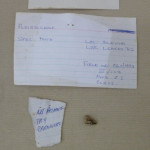 |
067/1984 |
8156 |
89 - HWK E (?) |
|
TOOTH |
|
122 - National Museum and House of Culture, Dar es Salaam, Tanzania |
|
|
|
-- |
Tooth. Pleistocene. Olduvai. Label in bag with specimen states "Not primate, try carnivore". other label in bag states "III/1/2 HWK E. I OLD62". |
|
2012/07/30 |
264 - Leakey family expedition |
Unknown |
|
Mammalia |
|
|
|
|
|
|
|
|
|
|
Label in bag with specimen states "Not primate, try carnivore". |
No |
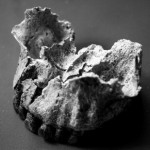 |
OH 65 |
3780 |
|
82 - 64 |
MAX
, TOOTH |
1995 |
127 - National Natural History Museum, Arusha, Tanzania |
I |
Middle/Upper |
|
Blumenschine, R. J., Peters, C. R., Masao, F. T., et al. 2003. Late Pliocene Homo and Hominid Land Use from Western Olduvai Gorge, Tanzania. Science 299, 1217-1221. |
Author describes specimen as "complete maxilla with all teeth and lower face of adult".�Specimen is pictured in images 1-11. (Images from R. Clarke 2011). |
|
|
|
Yes |
|
Mammalia |
Primates |
Anthropoidea |
Haplorhini |
Hominoidea |
Hominidae |
Homininae |
Hominini |
Homo |
habilis |
|
Large habilis |
No |
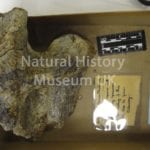 |
OLD-119 |
12409 |
|
|
CRA-f |
|
114 - Natural History Museum UK |
|
|
|
-- |
OLD-119; based on note with specimen, may not be from Olduvai |
|
|
|
Unknown |
|
Mammalia |
|
|
|
|
|
|
|
|
|
|
large mammal |
Yes |
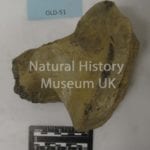 |
OLD-51 |
12683 |
|
|
PHX |
|
114 - Natural History Museum UK |
|
|
|
-- |
OLD-51; pedal bone |
|
|
|
Unknown |
|
Mammalia |
|
|
|
|
|
|
|
|
|
|
large mammal |
No |
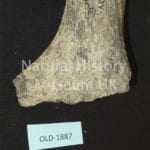 |
OLD-1887 |
13215 |
|
|
PVG-f |
|
114 - Natural History Museum UK |
|
|
|
-- |
OLD-1887; os coxae-f |
|
|
|
Unknown |
|
Mammalia |
|
|
|
|
|
|
|
|
|
|
large mammal |
Unknown |
 |
OH 16 |
3731 |
72 - FLK Maiko Gully |
283 - 45 |
CRA-f
, TOOTH
, MAN
, |
1963 |
122 - National Museum and House of Culture, Dar es Salaam, Tanzania |
II |
base |
| Leakey MD. (1971) Olduvai Gorge, Vol. 3: excavations in Beds I & II 1960-1963. New York, NY: Cambridge University Press. |
Upper and lower dentition, calotte, and > 1500 unidentified fragments due to cattle trampling. Majority of fragments found on surface of Tuff IF, some teeth found in situ, 2 feet above Tuff IF. Specimen previously housed at National Museum of Kenya. |
154 - Leakey and Leakey |
|
264 - Leakey family expedition |
No |
|
Mammalia |
Primates |
Anthropoidea |
Haplorhini |
Hominoidea |
Hominidae |
Homininae |
Hominini |
Homo |
habilis |
|
Leakey LSB, 1964 refers to this specimen as Homo erectus. Leakey, Tobias, and Napier provisionally assign it to Homo habilis (referred material, not paratype) (1964), and Leakey MD, 1971 refers to it as cf. Australopithecus. |
Yes |
|
II-40 |
7675 |
|
|
|
|
|
|
|
|
Gentry, A., Gentry, A., and Mayr, H. 1995. Rediscovery of fossil antelope holotypes (Mammalia, Bovidae) collected from Olduvai Gorge, Tanzania, in 1913. Bayerische Staatssammlung fur Palaontologie und |
|
|
|
|
Unknown |
|
Mammalia |
Artiodactyla |
Ruminantia |
|
Bovoidea |
Bovidae |
Antilopinae |
Antilopini |
Gazella |
gazella |
praecursor |
Listed as a paratype of G. g. praecursor. Was not listed in Schwarz (1937) did not list it as a paratype and its status is no different from that of the hypodigm of the species. "It is certainly not an antilopine bovid, but little more can be surmised about the identity." |
No |
|
II-40 |
3914 |
|
|
R-MAN |
|
|
|
|
|
Gentry, A., Gentry, A., and Mayr, H. 1995. Rediscovery of fossil antelope holotypes (Mammalia, Bovidae) collected from Olduvai Gorge, Tanzania, in 1913. Bayerische Staatssammlung fur Palaontologie und |
Right mandible with P3 to M1 |
|
|
|
Unknown |
|
Mammalia |
Artiodactyla |
Ruminantia |
|
Bovoidea |
Bovidae |
Antilopinae |
Antilopini |
Gazella |
gazella |
praecursor |
Listed as a paratype of G. g. praecursor. Was not listed in Schwarz (1937) did not list it as a paratype and its status is no different from that of the hypodigm of the species. "It is certainly not an antilopine bovid, but little more can be surmised about the identity." |
No |
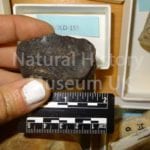 |
OLD-155 |
12446 |
|
|
CUBNAV |
|
114 - Natural History Museum UK |
|
|
|
-- |
OLD-155 |
|
|
|
Unknown |
|
Mammalia |
Perissodactyla |
Ceratomorpha |
Tapiromorpha |
Rhinocerotoidea |
Rhinocerotidae |
|
|
|
|
|
maybe Equid |
Unknown |
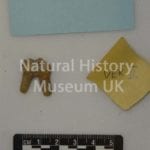 |
OLD-128 |
12419 |
|
|
M |
|
|
|
|
|
-- |
OLD-128 |
|
|
|
Unknown |
|
Mammalia |
Artiodactyla |
|
|
|
Hippopotamidae |
|
|
|
|
|
needs verification |
Yes |
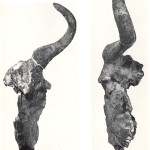 |
M. 21447 |
181 |
23 - TK |
|
CRA, L/R-MAX-f, L-HOR, L/R-P, L/R-M, L/R-I |
1931 |
106 - Natural History Museum UK (?) |
III, IV |
|
4 feet below Masek Beds |
Leakey LSB. 1965. Olduvai Gorge 1951-1961, Volume 1: Fauna and Background. New York, NY: Cambridge University Press. |
This neotype specimen is pictured in plates 81 and 82. The original holotype of M. kattwinkelli (VI-1099) was lost in WWII in Munich. |
130 - L.S.B. Leakey |
|
264 - Leakey family expedition |
Unknown |
|
Mammalia |
Artiodactyla |
Ruminantia |
|
Bovoidea |
Bovidae |
Alcelaphinae |
Alcelaphini |
Xenocephalus |
kattwinkelli |
|
Neotype - This specimen was reclassified by Gentry and Gentry (1978) as Megalotragus kattwinkeli. |
No |
 |
M 104204 |
12783 |
|
|
R-M |
|
114 - Natural History Museum UK |
|
|
|
-- |
OLD-657; right upper M3 |
|
|
|
Unknown |
|
|
|
|
|
|
|
|
|
|
|
|
none listed |
Yes |
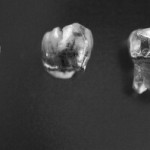 |
OH 68 |
3783 |
18 - VEK |
|
Mand-f, R-P-f |
2001 |
127 - National Natural History Museum, Arusha, Tanzania |
II |
Lower |
|
|
Mandible fragment with unerupted P4 and root of M1.�Specimen is pictured in the middle in image 1.�Specimen is shown in the middle of the top row in image 2. |
|
|
|
Yes |
|
Mammalia |
Primates |
Anthropoidea |
Haplorhini |
Hominoidea |
Hominidae |
|
|
Australopithecus |
africanus |
|
OH 13-like |
No |
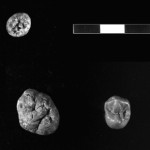 |
OH 70 |
3785 |
80 - MCK |
|
L-M-f |
2002 |
127 - National Natural History Museum, Arusha, Tanzania |
II |
Lower |
|
|
Distrobuccal portion of upper M1 crown.�Specimen is pictured on bottom right of image 1. |
|
|
|
Yes |
|
Mammalia |
Primates |
Anthropoidea |
Haplorhini |
Hominoidea |
Hominidae |
|
|
Australopithecus |
africanus |
|
OH 24-like |
No |
|
OH 78 |
3793 |
10 - BK |
|
H-f |
2007 |
127 - National Natural History Museum, Arusha, Tanzania |
II |
Lower-Middle? |
Surface. |
OLAPP/Earthwatch”Discovered by an Earthwatch project led by F.T. Masao in 2003 and 2004, respectively, and will be described elsewhere.” -R. Clarke (2011) |
Humerus shaft, subaerial weathering. |
|
|
|
No |
|
Mammalia |
Primates |
Anthropoidea |
Haplorhini |
Hominoidea |
Hominidae |
|
|
Australopithecus |
africanus |
|
OH 75-like |
No |
|
OVPP-Soricidae 1 |
3851 |
7 - FLK North |
|
L-MAN |
|
|
I |
2 |
|
Butler, P., and Greenwood, M. 1979. Soricidae (Mammalia) from the Early Pleistocene of Olduvai Gorge, Tanzania. Zoological Journal of the Linnean Society 67:329-379. |
Authors describe specimen as "left mandibular ramus with P4-M2 moderately worn, and with the roots of I1, I2, and M3. |
150 - Butler and Greenwood |
|
|
Unknown |
|
Mammalia |
Insectivora |
|
|
Soricoidea |
Soricidae |
|
|
|
|
|
One of five specimens of indeterminant species of Soricidae from Olduvai. Authors state that there appears to be three different species represented in the indeterminant specimens. This specimen is described as Species I. |
No |
|
OVPP-Soricidae 3 |
3853 |
24 - DK |
|
MAN |
|
|
I |
1 |
|
Butler, P., and Greenwood, M. 1979. Soricidae (Mammalia) from the Early Pleistocene of Olduvai Gorge, Tanzania. Zoological Journal of the Linnean Society 67:329-379. |
Broken left mandible with some worn teeth. |
150 - Butler and Greenwood |
|
|
Unknown |
|
Mammalia |
Insectivora |
|
|
Soricoidea |
Soricidae |
|
|
|
|
|
One of five specimens of indeterminant species of Soricidae from Olduvai. Authors state that there appears to be three different species represented in the indeterminant specimens. This specimen is described as Species III. |
No |
|
OVPP-Erinaceus 94 |
1944 |
7 - FLK North |
|
MAX-f, P, M |
|
104 - Unknown |
I |
upper |
3 |
Butler, P., and Greenwood, M. 1973. The early Pleistocene hedgehogs from Olduvai, Tanzania. Fossil vertebrates of Africa 3:7-42. |
|
150 - Butler and Greenwood |
|
|
Unknown |
|
Mammalia |
Lipotyphya |
|
|
Erinaceoidea |
Erinaceidae |
Erinaceinae |
|
Erinaceus |
broomi |
|
Order has more recently been determined as Insectivora |
No |
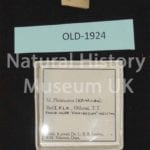 |
OLD-1924 |
13238 |
|
|
UK-f |
|
114 - Natural History Museum UK |
|
|
|
-- |
OLD-1924; egg fragment? |
|
|
|
Unknown |
|
|
|
|
|
|
|
|
|
|
|
|
ostrich egg? |
Unknown |
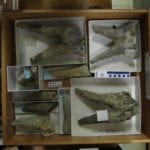 |
M 103977 |
12527 |
|
|
HOR |
|
114 - Natural History Museum UK |
II |
|
|
-- |
OLD-264 |
|
|
|
Unknown |
|
Mammalia |
Artiodactyla |
Ruminantia |
|
Bovoidea |
Bovidae |
Alcelaphinae |
Alcelaphini |
Parmularius |
|
|
P. angusticornis or P. altidens |
Unknown |
|
OLD 1960 F200 |
3714 |
5 - FLK |
|
R-MAN-f, d-P, M |
1960 |
105 - National Museum and House of Culture, Dar es Salaam, Tanzania (?) |
I |
|
|
Harris, J. M., Solounias, N., and Geraads, D. 2010. Giraffoidea. Werdelin, L., Sanders, W. J., eds. In: Cenozoic Mammals of Africa. London: University of California Press. pp. 393-428. |
Original information indicated that this specimen was located in Nairobi. This specimen is likely within the material that was repatriated to Dar in 2011, but this has yet to be confirmed. |
155 - Harris, Solounias, and Geraads |
|
264 - Leakey family expedition |
Unknown |
|
Mammalia |
Artiodactyla |
Ruminantia |
|
Giraffoidea |
Giraffidae |
Giraffinae |
Giraffini |
Giraffa |
pygmaea |
|
Paratype |
No |
 |
OH 4 |
3720 |
8 - MK |
281 - 11 |
P
, M
, MAN |
1959 |
122 - National Museum and House of Culture, Dar es Salaam, Tanzania |
I |
Lower |
Surface. |
Leakey, L.S.B., Tobias, P.V. & Napier, J.R. 1964. A new species of the genus Homo from Olduvai Gorge. Nature 202(4927): 7-9. |
Paratype. Two isolated teeth (lower molar and upper premolar) and one M3 in a mandible. Found in small block of consolidated tuff. �Specimen previously housed at National Museum of Kenya. |
282 - H. Mukiri |
|
264 - Leakey family expedition |
Yes |
|
Mammalia |
Primates |
Anthropoidea |
Haplorhini |
Hominoidea |
Hominidae |
Homininae |
Hominini |
Homo |
habilis |
|
Paratype |
No |
 |
OH 8 |
3723 |
6 - FLK NN |
283 - 45 |
PHX
, CAR
, TAR
, CLA
, AST
, CAL
, CUNE
, CUB
, NAV
, M-f |
1960 |
122 - National Museum and House of Culture, Dar es Salaam, Tanzania |
I |
3 |
|
Leakey MD. (1971) Olduvai Gorge, Vol. 3: excavations in Beds I & II 1960-1963. New York, NY: Cambridge University Press. |
The molar-f was found on the surface and "probably also belongs to OH 8" (Leakey MD, 1971:228). Twelve associated foot bones including astragalus (has carnivore tooth marks (Leakey MD, 1971), calcaneus, cuboid and navicular, cuneiforms 1- 3, proximal ends with shafts, five metatarsals. Proximal ends of one metacarpal and three finger phalanges. One radius shaft. Clavicle with damaged articular ends. Foot articulates "almost perfectly with the OH 35 leg" (Susman, 1983:372). |
130 - L.S.B. Leakey |
|
264 - Leakey family expedition |
Yes |
|
Mammalia |
Primates |
Anthropoidea |
Haplorhini |
Hominoidea |
Hominidae |
Homininae |
Hominini |
Homo |
habilis |
|
Paratype |
No |
 |
OH 13 |
3728 |
27 - MNK |
287 - 88 "Skull Site" |
MAN
, MAX
, CRA-f |
1963 |
122 - National Museum and House of Culture, Dar es Salaam, Tanzania |
II |
Lower Middle IIB |
5 feet above chert horizon |
|
Paratpye. "This consists of a sub-adult skull, probably female, with the third molars coming into wear. It is represented by the greater part of the mandible, including the complete dentition, although the crowns of the incisors are damaged and the left ascending ram us is not preserved; the greater part of the maxillae, represented by two fragments both lacking the anterior portions; the greater part of the occipital; the right parietal and temporal; parts of the left parietal and temporal; together with a few frontal fragments and approximately fifty additional pieces which it has not been possible to fit together" (Leakey MD, 1971:231). Specimen previously housed at National Museum of Kenya. 5 pieces found at House of Culture, Dar es Salaam, Tanzania. |
130 - L.S.B. Leakey |
|
264 - Leakey family expedition |
Yes |
|
Mammalia |
Primates |
Anthropoidea |
Haplorhini |
Hominoidea |
Hominidae |
Homininae |
Hominini |
Homo |
habilis |
|
Paratype |
No |
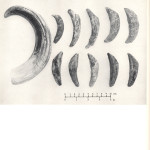 |
FLK NN I 701 |
103 |
6 - FLK NN |
|
C |
|
104 - Unknown |
I |
middle |
2 |
Leakey LSB. 1965. Olduvai Gorge 1951-1961, Volume 1: Fauna and Background. New York, NY: Cambridge University Press. |
This specimen is pictured in plate 24 next to modern Phacochoerus specimens. |
130 - L.S.B. Leakey |
|
264 - Leakey family expedition |
Unknown |
|
Mammalia |
Artiodactyla |
Suiformes |
|
Suoidea |
Suidae |
Suinae |
Suini |
Promesochoerus |
mukiri |
|
Paratype |
No |

















